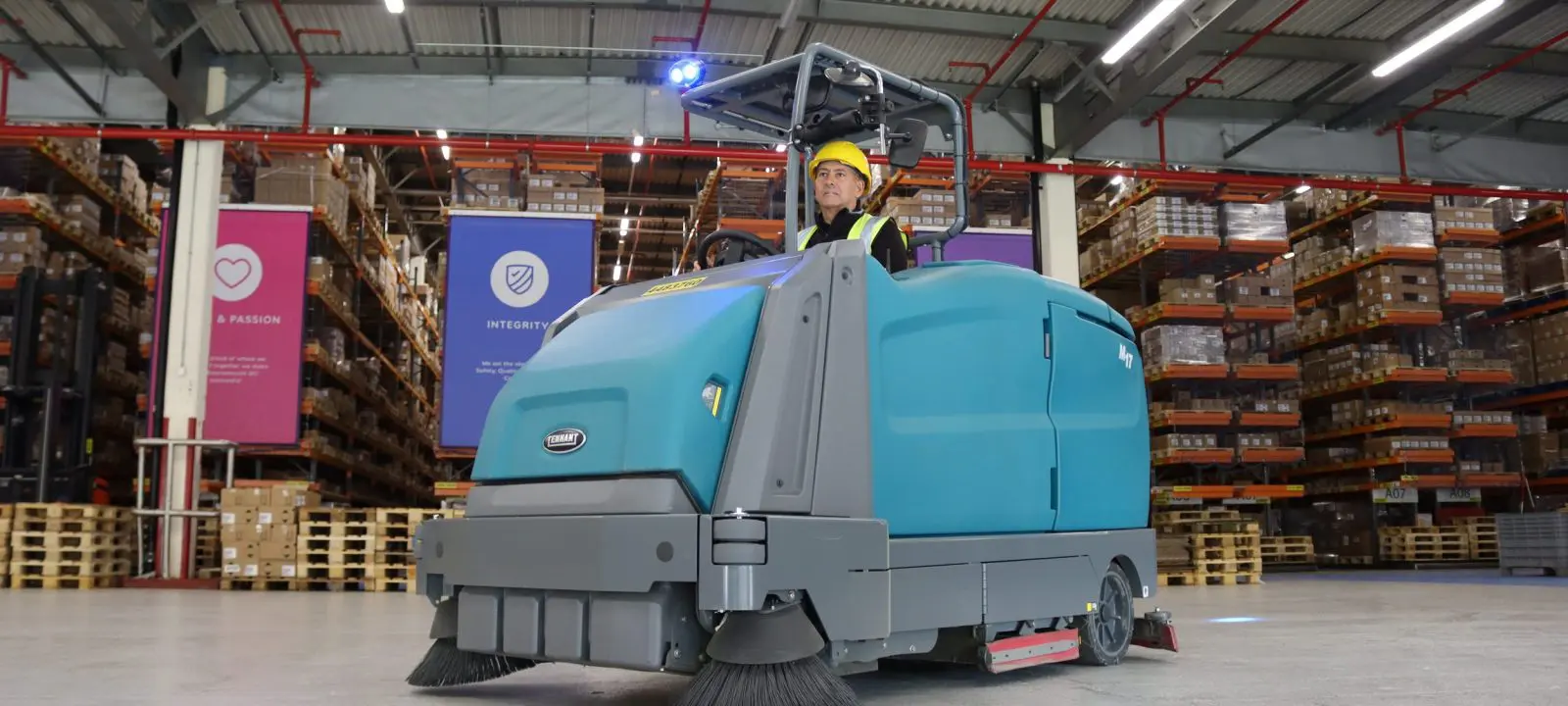Warehouses are among the most demanding working environments to keep clean. They involve a high concentration of staff and machines, which may mean that cleaning during operational hours is necessary to maintain quality standards. And, in many cases, warehouse operations work continuously on a rolling shift pattern, in which case, cleaning would certainly have to be planned around that.
There is also a great disparity between the areas to clean: a warehouse with concrete floors, racking and packing areas is very different from the team welfare room or an admin office.
Health and safety restrictions will be at their peak too, especially with heavy machinery and goods in the area. Compliance in a warehouse environment is non-negotiable.
The key to success for a warehouse cleaning team is to manage these challenges. Staff must be trained to clean very diverse areas with the right equipment. It can be worthwhile to split teams into sub-groups that specialise in particular areas. They may have to work around busy warehouse staff without disrupting the operation. Risk assessments and other compliance must be kept up to date and enforced. Strategic leadership underpins all of these demands.
The best cleaning teams work as ‘one team’ with the customer. This means that the cleaning operatives are so attuned to the demands of the warehouse and the customer’s objectives that their cleaning work is focused entirely on helping the customer achieve those objectives. The cleaning must be as integrated with the warehouse operation as possible.
Warehouses normally comprise 5 sections:
- Interiors
- Bathrooms
- Break rooms
- Office areas
- Exteriors
It is important to clean all of these areas whilst maintaining a safe environment for all involved.
How to keep your warehouse clean and safe
There are some tasks that a warehouse cleaning team should complete immediately, to maintain a safe environment. These include cleaning up spills, tidying tools away, and litter-picking. Part of the ‘one team’ approach mentioned earlier is for cleaning operatives to be vigilant on behalf of everyone, spotting hazards and irregularities (e.g. damaged goods) and either dealing with them directly, or reporting them immediately, even if they are officially another person’s job. Part of the ‘one team’ approach is to be spot hazards on behalf of everyone.
Other than immediate, ad hoc tasks, a good warehouse cleaning checklist should be organised in terms of daily, weekly and monthly (or less frequent) tasks – as detailed below. Also, whilst this is not an exhaustive warehouse health and safety checklist, it offers an overview of the level of compliance required.
Daily warehouse cleaning checklist
As we have seen, a warehouse environment will likely involve large numbers of staff working in an industrial environment, possibly on a continuous cycle. To stay on top of this intensive cleaning demand, a more janitorial model may be required, with an operative(s) presence throughout the shift.
- Cleaning of pick-and-pack areas. With orders may be fulfilled by warehouse staff continuously, with little or no down time, the cleaning team must learn the working habits and culture of the warehouse. Then they can adapt their service discreetly around them, for example during breaktimes when members of staff are elsewhere.
- Sweep and litter-pick gangways to keep them clear of debris or trip hazards.
- Keep on top of dust build-up. A site’s HGV and machine presence could generate a large amount of dust, which can easily become an airborne health hazard. So, it’s important to clear it throughout the shift.
- Offices, meeting rooms and other admin areas require a more refined kind of cleaning. Wipe surfaces, vacuum carpets, and sanitise touchpoints like light switches and door handles.
- Welfare/break areas should be maintained as pleasant spaces for staff. Clearing tables and kitchen areas is key here. Consider a janitorial style of cleaning, with regular visits to these areas to keep them clean and tidy, especially when used in large numbers over extended periods.
- Washrooms are naturally a focal point for hygiene. When used intensively by staff in an industrial environment, these will require repeat visits in a janitorial style to maintain standards. Sanitising touchpoints like flushes, taps and door handles is important.
- A warehouse produces large quantities of packaging waste, largely cardboard. A dedicated team member may be required to clear cardboard packaging before it becomes a hazard, and take it to a recycling zone or compactor. Operatives may also need to use a forklift, which would require a qualification.
- External areas should be included in the specification, especially waste disposal zones to be kept tidy and safe, to avoid injury, infection or pests. Walkways, smoking areas or other commonly used outdoor zones should be checked for litter or trip hazards.
Weekly warehouse cleaning checklist
- Overflowing bins are both an eyesore and a health hazard. Monitor them especially in high footfall areas.
- Floors that are swept each day will require cleaning at least once a week (or more in wet weather). Clean hard floors in gangways, washrooms and other welfare areas either by mopping or by use of a scrubber-dryer machine.
- Clear empty pallets, or redundant objects stored on racking. Agree a clear strategy with the client to keep the work areas free of unnecessary clutter that can hamper productivity. Again, a qualified forklift driver may be necessary.
Monthly warehouse cleaning checklist
Most warehouses dust can be kept under control at ground level during the daily operation, but harder-to-reach areas require attention intermittently, too.
- To clean high level racking, ventilators, fans, sills or other hard-to-reach areas will require powered access equipment such as cherry pickers or scissor lifts. Operatives will need an IPAF (International Powered Access Federation) license to operate these.
- Check materials/consumables stock levels, and try to order in bulk with fewer deliveries to save carbon emissions.
Biannual warehouse cleaning checklist
There are some cleaning tasks that you should carry out roughly twice per year:
Carry out an audit for items you no longer use and sort through these items, disposing of any you don’t need appropriately.
Assess the layout of the warehouse and ensure that it’s still fit for purpose, and that cleaning has been effective
The benefits of a clean warehouse
A clean, uncluttered working environment has a positive impact on productivity and overall wellbeing. With staff working long, demanding shifts, the quality of their environment is important and this can be maintained with a warehouse cleaning plan.
Good overall hygiene aids physical wellbeing too, with less productivity lost due to sickness absence.
Warehouses pose an above-average risk for employees, with mechanised equipment, HGVs and bulky items. A tidy, uncluttered workplace will help prevent harm to people or damage to merchandise through accidents. Relevant risk assessments should be implemented.
A clean warehouse also prolongs the life of its physical assets and any equipment used around site – it’s also crucial when considering what warehouse security is, as this involves cleanliness as well as protection via guarding etc
How did the COVID-19 pandemic affect warehouse cleaning?
During the pandemic, there were severe shortages of warehouse staff to fulfil orders, due to infection rates and lockdown restrictions. The same applied to cleaning teams. Cleaning providers were forced to use their remaining operatives as strategically as possible, prioritising tasks and supporting warehouse hygiene so that they could continue to operate throughout the pandemic.
A major cosmetics distributor had this to say about Samsic UK, their warehouse cleaning provider: “Without such strong leadership, and such a great team, we would not have been able to continue the operation throughout the peak COVID rates in the local area.”
Benefits of using a contracted cleaning company to clean your warehouse
We have seen how warehouse environments are intensive, continuous operating environments with a concentration of staff and machinery spread over diverse work areas. A cleaning team must be multi-skilled, highly organised and well-equipped to sustain this complex, demanding warehouse cleaning plan. Strategic leadership that can adapt to changing times (e.g. the pandemic, or staff shortages) is crucial, as is compliance to health and safety requirements.
To manage these functions in-house demands substantial resources, which is why outsourcing to professionals with established expertise makes most sense. A cleaning company takes ownership of the entire warehouse cleaning checklist, leaving your business free to focus on what it does best. To summarise, cleaning companies offer the advantage by:
- Drawing on a broad pool of combined expertise and resources in warehouse cleaning, to deliver best practice consistently over the longer term.
- Recruiting, managing and retaining quality cleaning staff in a sector where this can be a challenge. This includes absence cover.
- Delivering industry-standard training to build truly effective cleaning teams.
- Fulfilling health, safety, welfare and all other forms of critical compliance, such as chemical usage, PPE, risk assessments and more.
- Offering a genuinely sustainable cleaning service, with a commitment to staff welfare. Demonstrating a strategy for Environmental, Social and Governance (ESG) is a must in today’s market.
The next step
Samsic UK is the go-to warehouse cleaning provider for high-profile brands across the UK. Get in touch to start a conversation about how our proven skills and experience could transform your warehouse. contact page.








